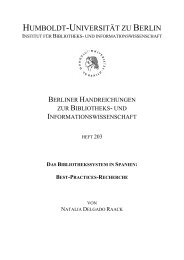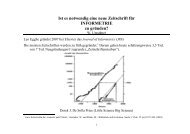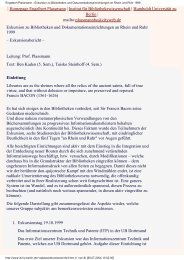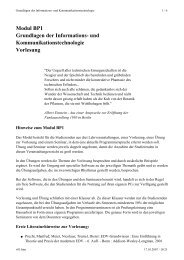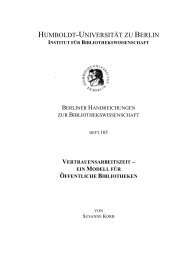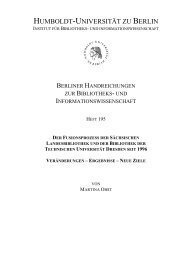An exploratory study of Google Scholar
An exploratory study of Google Scholar
An exploratory study of Google Scholar
Create successful ePaper yourself
Turn your PDF publications into a flip-book with our unique Google optimized e-Paper software.
provide, approximately 300 million science-specific web pages. In addition to scientific<br />
documents from Elsevier (ScienceDirect server, see http://www.sciencedirect.com/) freely<br />
accessible documents, many from public web servers at academic institutions, are provided.<br />
Among these are, for example, documents placed by students that do not fulfil scientific<br />
criteria such as peer review which <strong>of</strong>ten lead to their exclusion in searches. In our experience<br />
there is more than a negligible fraction <strong>of</strong> records from non-academic web spaces in the<br />
Scirus index. Scirus’ coverage <strong>of</strong> purely scientific sources in addition to Elsevier's<br />
ScienceDirect full-text collection is low by comparison (compare the selection <strong>of</strong> hosts in the<br />
Scirus advanced search interface, http://scirus.com/srsapp/advanced/). What Scirus declares as<br />
the ‘rest <strong>of</strong> the scientific web’ is too general, non-specifically filtered and makes up the<br />
majority <strong>of</strong> hits in any query.<br />
As seen in the pilot project CrossRef Search, the chosen <strong>Google</strong> <strong>Scholar</strong> approach is to work<br />
in cooperation with academic publishers. What is significant about the <strong>Google</strong> <strong>Scholar</strong><br />
approach?<br />
First and foremost, what stands out is that <strong>Google</strong> <strong>Scholar</strong>, as previously mentioned, delivers<br />
results restricted to exclusively scientific documents and this constraint has yet to be<br />
consistently implemented by any other search engine. <strong>Google</strong> <strong>Scholar</strong> is a freely available<br />
service with a familiar interface similar to <strong>Google</strong> Web Search. Much <strong>of</strong> the content indexed<br />
by <strong>Google</strong> <strong>Scholar</strong> is stored on publishers’ servers where full-text documents can be<br />
downloaded for a fee, but at least the abstracts <strong>of</strong> the documents found will be displayed at no<br />
cost. The <strong>Google</strong> approach does, however, provide documents from the open access and selfarchiving<br />
areas (compare Swan and Brown, 2005).<br />
In addition to the full-text access users might also be interested in the analysis implemented<br />
by <strong>Google</strong> and the document ranking based on this analysis. The relevance ranking is based<br />
on various criteria (see citation below). According to this the citation value <strong>of</strong> a document is<br />
only one factor contributing to its ranking. <strong>Google</strong> builds a citation index out <strong>of</strong> the full-text<br />
index as an add-on to its service. On top <strong>of</strong> the statistical best match ranking <strong>of</strong> full-texts, this<br />
add-on implementation can be valuable for re-ranking documents or for analysis and<br />
evaluation purposes <strong>of</strong> certain document sets. Automatic reference extraction and analysis,<br />
also known as Autonomous Citation Indexing (ACI), can be particularly helpful for the user<br />
in information retrieval and delivery. This process ensures that <strong>of</strong>ten cited scientific works<br />
will be ranked more highly in the results list thereby making them more visible to the user.<br />
Additionally the user can track all citing works extracted by ACI which need not necessarily<br />
be included in the full-text index or contain the original user search term. The automatic ACI<br />
process necessitates that references in the documents analyzed be available, which is, per se,<br />
for granted if full-texts are analyzed. This procedure also enables <strong>Google</strong> <strong>Scholar</strong> to present<br />
additional references not found on the indexed web servers.<br />
Figure 1 is a graphic representation <strong>of</strong> the <strong>Google</strong> <strong>Scholar</strong> approach including the value added<br />
service ACI. The three different citing styles for the same reference seen in figure 1 are taken<br />
from Lawrence, Giles & Bollacker (1999) and are intended to illustrate the difficulties in<br />
dealing with automatic normalization <strong>of</strong> references. The original system CiteSeer<br />
(http://citeseer.ist.psu.edu/) as well as <strong>Google</strong> <strong>Scholar</strong> have up to now implemented only<br />
heuristics for the application <strong>of</strong> ACI that also produce some errors in the citation values (see<br />
also Jacsó, 2005c; 2006a; 2006b).<br />
3






